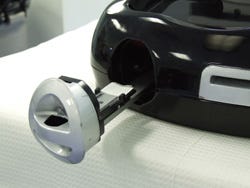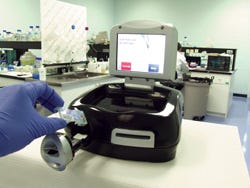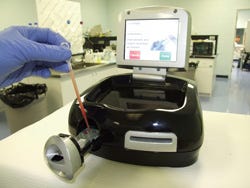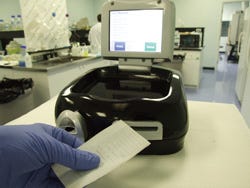Medical device products include disposable medical supplies, wound-management supplies, and diagnostic products. In vitro diagnostics (IVD) is the medical device market segment that includes reagents, diagnostic test products, instrumentation, and related items supplied to both clinical and research laboratories. It refers to testing that aims to identify disease states outside the body, using substances such as body fluids (e.g., blood and urine) and tissues
September 24, 2010
|
A user initiates the machine by opening and tapping an intuitive touch screen user interface. |
(biopsies and tissue sections).
Immunoassays are chemical tests used to detect or quantify a specific substance—the analyte—in a blood or body fluid sample, using an immunological reaction.1 Immunoassays are a key element in the diagnosis of various medical conditions including cardiac events. Since the mid-1960s, immunoassays have made a major contribution to clinical lab work, and in recent years, they have dominated the IVD product market and represented about a third of all testing in clinical laboratories. New technologies are quickly being developed that may dramatically raise the popularity of POC immunoassays.
With the incidence of cardiovascular disease on the rise, one variety of biological sample that has attracted attention for its use in testing is whole blood. Proteins (cardiac markers) are released in blood when the heart is damaged. These markers can be detected by immunoassays. Physicians can use them to diagnose a cardiac event or evaluate the likelihood that such an event will occur. Traditional markers for the first of these uses include CK-MB, troponin, and myoglobin; cholesterol is a popular marker for the latter use.
|
The user opens the cartridge door and inserts the cartridge for the desired test. |
In the past several years, other markers have come to the fore, including myeloperoxidase (MPO), brain natriuretic peptide (BNP), and proBNP. Several other new markers—including high-sensitivity C-reactive protein (hsCRP), homocysteine, fatty acid binding protein (FABP), glycogen phosphorylase isoenzyme BB (GPBB), urinary albumin, S-100 protein, and hemoglobin A1c (hbA1c)—are becoming part of the acute-care test menu as well as part of the risk-evaluation toolbox. With an annual growth of 5%, the world market for cardiac markers is expected to reach $1.05 billion by 2012.2
As more is learned about cardiovascular disease and its links to diabetes, lipid metabolism, and inflammation, the definition of a cardiac marker expands. It is expected that medical research will indicate the mix and match of various analytes, according to specific cardiac conditions such as stroke, thrombosis, heart attack, and cardiovascular risk. Microfluidics and digital optics are the market enablers for this type of testing. Therefore, the development of lab-on-a-chip (LOC) and similar devices that drive lab-quality results will come into play.
POC Test Market Growth
One vital application for cardiac markers is the point-of-care (POC) test market, encompassing those diagnostic tests that can be conducted at or near the site of patient care. IVD sales of POC tests include those for patient self-testing; rapid tests used in professional settings, such as physician office laboratories (POLs) and clinics; and rapid tests performed in the hospital. Other POC tests, such as those to identify drugs of abuse, are administered in the
|
The user adds the sample to the cartridge and closes the door to insert the cartridge into the machine thus initiating the test. |
workplace and within the criminal justice system. Currently, there is no commercially available immunodiagnostic POC platform that offers quality results on par with what is obtainable in medical laboratories, and this has led to a large-scale reluctance on the part of physicians to adopt POC platforms to diagnose patients. Worldwide, there is still a perception that POC tests are more expensive than lab-based tests. And yet, after many years of slow growth, the professional POC test market is beginning to come alive. For example, in 2006–2007, demand for quicker test turnaround spurred the launch of at least 15 new POC tests and devices, and at least another 15 are near market. The market for professional POC immunoassays is estimated at $1.625 billion; with 14% growth, this market segment will reach $2.77 billion in 2012.2
Today, physicians are looking to increase the number of tests they can conduct in their offices. Meanwhile, in the hospital setting, there is pressure for quicker turnaround times and for more-efficient patient management to minimize patients’ length of stay. This pressure provides an incentive for diagnostics companies to develop new POC testing technologies. Evidence for this includes continued growth in the market for critical-care analyzers.
Faster and More-Accurate Diagnoses
|
Results are displayed on the LCD, electronically stored in the machine, or forwarded to desired network. |
A prime motivation for the development of new POC technology is the desire to reduce the time required to diagnose cardiac events such as heart attacks. When it comes to cardiac events and survival, the key factors for a successful recovery include the time required for diagnosis, the accuracy of that diagnosis, and appropriate clinical management.
The diagnosis of myocardial infarction is traditionally made by integrating the history of the presenting illness and physical examination with electrocardiogram findings and cardiac markers (i.e., blood tests for heart muscle cell damage).3 A coronary angiogram allows visualization of narrowings or obstructions on the heart vessels, and therapeutic measures can follow immediately. A chest radiograph and routine blood tests may indicate complications or precipitating causes and are often performed upon arrival to an emergency department. New regional wall motion abnormalities on an echocardiogram (ECG) are also suggestive of a myocardial infarction. Echo may be performed in equivocal cases by the on-call cardiologist.4 In stable patients whose symptoms have resolved by the time of evaluation, Technetium (99mTc) sestamibi (i.e., an MIBI scan) or thallium-201 chloride can be used in nuclear medicine to visualize areas of reduced blood flow in conjunction with physiologic or pharmocologic stress.4 Thallium may also be used to determine viability of tissue, distinguishing whether nonfunctional myocardium is actually dead or merely in a state of hibernation or of being stunned.5
However, existing techniques such as the ones described above harbor several drawbacks. For example, an ECG represents a brief sample in time; because unstable ischemic syndromes have rapidly changing supply versus
|
Results can also be printed on an internal printer. The single-use cartridge is removed and disposed, readying the machine for the next test. |
demand characteristics, a single ECG may not accurately represent the entire picture.6 In addition, the analysis of cardiac markers requires access to diagnostic technology that is traditionally located in hospitals and other healthcare facilities. Optimally, patients experiencing a cardiac event would receive a diagnosis in a matter of minutes, but such speed is not always feasible when a test sample must be delivered to an indoor facility for analysis.
The prime motivation of developing POC immunoassay platforms, therefore, is to decrease diagnosis time to the bare minimum while ensuring that the diagnosis maintains an accuracy on par with what is available with the best hospital-based equipment. A secondary motivation is to keep costs low; this is important in an era when, for example, a single scan from a multidetector cardiac CT can cost between $700 and $1200.7 The chief cause of POC’s limited market penetration up until now has been the state of the technology involved. Most rapid POC tests are based on qualitative chromatographic techniques with results that are detected visually. However, as imaging and computational capabilities have improved, a significant trend has appeared within the diagnostics industry to replace visual detection with digital and instrument-based methods. The goal of LOC devices is to progress from obtaining a biological sample to obtaining a result in one easy step, by placing the sample in the device. Each LOC could feature full calibration and quality control capabilities as well as built-in connectivity.
New POC Immunoassay Devices
Several advances in technology will likely distinguish the coming generation of POC immunoassay devices. For example, the most successful of these devices will likely be fully portable, fully automated, and compact, as well as capable of delivering accurate results of complex medical tests anywhere, including in emergency rooms, doctors’ offices, and EMS vehicles. They will be very light and will be operated by rechargeable batteries. In addition, the devices will be capable of being operated by personnel who lack specific laboratory training as well as by testing specialists. Once test results have been obtained, the data should be transferable to any computer network. The test results ought to be easily viewable on a readout screen and should be printable.
Two standout features have been envisioned for use with POC immunoassay devices. The first of these is the use of disposable, single-use test cartridges, which can be loaded into the devices and which come prepackaged with all necessary reagents to perform a specific test when a patient’s whole blood sample is added to it. Each cartridge should be uniquely identifiable, say, by a bar code that contains a set of data including the type of test, lot number, expiration date, and calibration curve that will allow the machine to assess test results.
A second important feature that may distinguish POC devices is the use of chemiluminescence to ensure the highest test sensitivity. The light emitted by the chemical reaction resulting from the combination of the patient’s blood and a specific reagent can be measured and a diagnosis rendered. Existing laboratory machines that employ chemiluminescence typically use mechanical means, including pipette injectors, pumps, and valves to deliver the final trigger compound that is required to initiate light generation; however, it is also possible to use an electronic signal as a trigger, which allows the delivery of reagents with precise timing. A photomultiplier and photocounter could then be used to analyze the emitted light.
As a concrete example of the coming generation of POC devices, consider the QL Care Analyzer (QLCA), currently being developed by CardioGenics Inc. of Mississauga, ON, Canada. It incorporates many of the features highlighted above. Measuring 8 × 9 × 5 in., it weighs about 7 lb. It is powered by a rechargeable lithium-ion battery and includes a memory processor with the storage capacity to hold up to 5000 patient records. It can deliver the results of a specific test within 15 minutes (as opposed to the 2.8 hours that lab-based immunodiagnostics currently require to deliver results) and RS-323 and USB ports are included for data transfer. An LCD touch screen incorporates an intuitive graphical user interface. Finally, the QLCA employs both disposable test cartridges and chemiluminescence.
In use, an elementary series of steps are required to operate the QLCA. To begin, the user starts the operation of the machine by opening and tapping the user interface LCD touch screen. Second, the cartridge door is opened and the cartridge for the desired test is put in. Then, a nonmetered blood sample is added to the cartridge, and the door is closed to secure the cartridge inside the machine. The machine then automatically identifies the type of test from the bar code on the cartridge, loads the required calibration software, and runs the test. The operator enters information about the patient as the test runs. Lastly, the results are displayed on the LCD and electronically stored in the machine; they can be forwarded to a desired network or printed out.
CardioGenics is hardly alone in pursuing this form of technology. Other major industry participants with an interest in immunoassay analyzers include Roche Diagnostics, Abbott Diagnostics, and Siemens Medical Solutions Diagnostics, as well as Johnson & Johnson and Becton Dickinson. For example, Roche offers POC testing products in several categories, including cardiac markers. That company’s Cardiac Reader provides quantitative results of troponin T, myoglobin, and D-dimer levels for POC diagnosis of acute coronary syndrome, deep vein thrombosis, and pulmonary embolism. Its TROP T Sensitive Rapid Assay is designed to provide a qualitative test for a myocardial damage marker, while its ACCU-CHEK Instant Plus system is a handheld system for cholesterol and glucose testing.
The advanced biosensor technology of the i-STAT System, manufactured by Abbott, enables patient-side blood testing, so that healthcare professionals can access real-time, lab-quality results within minutes. Lightweight, portable, and easy to use, the i-STAT System features single-use disposable cartridges that perform a broad menu of the most commonly performed diagnostic tests, including cardiac markers, blood gases, chemistries and electrolytes, lactate, coagulation, and hematology.
The DCA Vantage Analyzer, from Siemens, is designed to drive diabetes patient compliance with clinically proven HbA1c, albumin, and creatinine tests and albumin-to-creatinine ratio results. According to the manufacturer, the device delivers HbA1c results in 6 minutes. Microalbumin testing, which allows for early detection of kidney disease, delivers results in 7 minutes.
A relatively smaller company, PointCare, has created PointCare NOW, a POC device that according to the company can determine within the span of 8 minutes a number of properties of a blood sample. These include CD4 absolute count and CD4%, total white blood cell count, and count and percent for lymphocytes, monocytes, neutrophil, and eosinophil.
In addition to facilitating quicker diagnoses for patients in the United States, it is interesting to note how such technology could assist healthcare efforts worldwide. It is clear that residents of countries in which the healthcare system is less technologically advanced than in the United States would benefit from the rollout of POC immunodiagnostic devices. In addition, a significant fraction of U.S. patients who travel overseas for surgery are doing so because of heart problems; in fact, heart surgery is one of the top five types of surgeries that motivate travel abroad.8 Once POC immunoanalyzers are sold abroad, the effect on such medical tourism will likely be significant. No longer would heart patients need to fret about a lack of a timely diagnosis in a foreign facility. The time required for accurate diagnosis will be reduced and roughly equalized everywhere.
A New Class of Tests
In the context of POC testing, the key to the diagnosis of heart problems and other ailments is to measure the difference between normal and abnormal concentrations of potential disease markers. Currently, most immunoassay technologies in routine use for POC do not have the sensitivity required to detect many disease-specific markers. Therefore, new, ultrasensitive test methodologies are needed to allow for testing these markers for cardiac disease, as well as other conditions. Immunoassay developers are on a continuous hunt to discover technologies that can detect nano-, pico- and even femtomolar concentrations of proteins in clinical samples.
Tests currently in development include a troponin I (TNI) test, which would detect the presence and quantity of this specific heart muscle protein, released in the bloodstream shortly after a heart attack; a plasminogen activator inhibitor type-1 (PAI-1) test, which would help optimize the performance of a heart drug prescribed for heart attack patients; a heart failure risk stratification test, which would assess the risk of death in heart failure patients; and a heart failure genomics risk test, which would predict the response of heart failure patients to routinely administered drugs. All of these tests have either been developed or are being studied by CardioGenics, the manufacturer of the QLCA. Other tests have been proposed for cancer, allergy, autoimmune disorders, cardiovascular problems, and sepsis.
Conclusion
As we have seen, there is a considerable potential for POC immunoassay platforms to improve the time to diagnosis for various conditions, including cardiac episodes. As new technology is rolled out and physicians are able to assess the performance characteristics of various new platforms, devices and tests, it is possible that this will come to represent a new standard of care among healthcare providers who are committed to diagnosing their patients as quickly and as accurately as possible.
References
1. “Immunoassay tests” in Encyclopedia of Surgery; available from Internet: www.surgeryencyclopedia.com/Fi-La/Immunoassay-Tests.html; accessed June 16, 2010.
2. The Worldwide Market for In Vitro Diagnostic (IVD) Tests, 6th Ed. (Rockville, MD, and New York: Kalorama Information: 2008).
3. T Mallinson, “Myocardial Infarction,” Focus on First Aid (15):15; available from Internet: www.focusonfirstaid.co.uk/Magazine/issue15/index.aspx; accessed June 16, 2010.
4. DE Fenton, “Myocardial Infarction,” eMedicine; available from Internet: http://emedicine.medscape.com/article/759321-overview#section~workup; accessed June 16, 2010.
5. E Skoufis and AI McGhie, “Radionuclide Techniques for the Assessment of Myocardial Viability,” Texas Heart Institute Journal, 25, no. 4 (1998): 272–279.
6. CP Cannon et al., Management of Acute Coronary Syndromes, p. 175 (Totowa, NJ: Humana Press, 1999).
7. MV Kalayoglu, “64-Slice CT and the New Age for Cardiac Diagnostics,” Medcompare Technology Spotlight; available from Internet: www.medcompare.com/spotlight.asp?spotlightid=147; accessed June 16, 2010.
8. R-M Stephano, editor of Medical Tourism magazine, personal e-mail communication with author, March 18, 2010.
Yahia Gawad is the founder, CEO, and director of CardioGenics Inc. (Mississauga, ON, Canada).
About the Author(s)
You May Also Like







